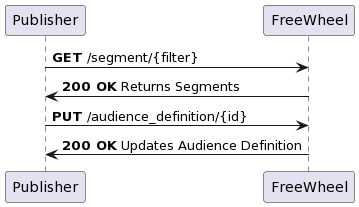Overview
The Audience Definition API V4 is a group of endpoints that provides key management of audience definitions and audience segments. By creating an audience definition, publishers can exert granular control over the location and traits of their target audience. Once defined, audience definitions can be used in placement and campaign targeting.
Audience definitions are reusable objects for all sites and site sections within a network. Audience definitions may draw from multiple data sources across providers, as well as combine data sources into one definition. They are defined by the third-party audience tracking provider you have chosen to integrate with MRM, not by FreeWheel.
| Feature | GET | POST | PUT | DELETE |
|---|---|---|---|---|
| Audience Definitions | X | X | X | X |
| Segments | X |
Leverage the Audience Definition API to accomplish the following tasks:
- Retrieve metadata for all audience definitions in a network
- Create and update an audience definition with segment targeting
- Return segments by data provider, name, segment ID, ingestion status, and number of segments per provider
Uniform Resource Identifiers (URI)
| Feature | Production URI | Staging URI |
|---|---|---|
| Audience Definition | https://api.freewheel.tv/services/v4/audience_definition | https://api.stg.freewheel.tv/services/v4/audience_definition |
| Segments | https://api.freewheel.tv/services/v4/segment/{parameter} | https://api.stg.freewheel.tv/services/v4/segment/{parameter} |
Workflows
Update an Audience Definition with a Segment

Publisher
- Requests segments by data provider or name.
FreeWheel
- Returns a list of segment IDs, as well as other segment information.
Publisher
- Adds the segment ID to the audience definition's
targetsarray.
FreeWheel
- Updates the audience definition with the new segment targeting.
Attributes
Audience Definition Attributes
The following attributes are used when creating an audience definition with the POST method. This table also provides information on whether the attribute can be updated via PUT. For an interactive example, see Create Audience Definition.
| Name | Type | Description | Mandatory? | Updatable? |
|---|---|---|---|---|
| id | integer | Audience definition ID used when updating | Yes | Yes |
| name | string | Name of the audience definition | Yes | Yes |
| description | string | Description of the audience definition | No | Yes |
| targets | array | Segment targeting of the audience definition | Yes | Yes |
| active | boolean | True if the audience definition should be activated, default value is false | No | Yes |
| graph_optimization | string | If the graph optimization is enabled. This is only applicable if the network graph optimization is set as "custom". Default empty string equals "off". | No | Yes |
Targets Child Attributes
| Name | Type | Description | Mandatory? | Updatable? |
|---|---|---|---|---|
| kind | string | INCLUDE or EXCLUDE from targeting | Yes | Yes |
| target_ids | array of strings | Array of FreeWheel segment IDs for targeting | Yes | Yes |
